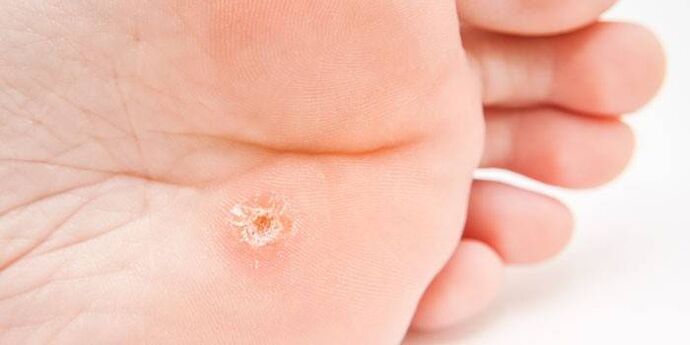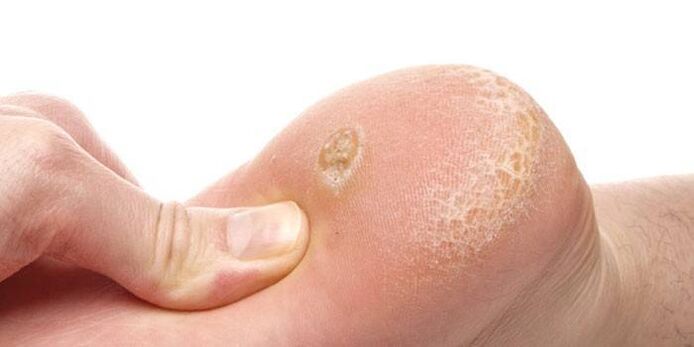Ugly structures on the body have been disturbing humanity since ancient times. A wart on the foot is a skin condition caused by viruses. People with skin defects were shunned for fear of infection and when they noticed a neoplasm on the sole of the foot or another part of the body, tried to remove it as soon as possible. What people don't apply to their plantar warts if only they go away forever. So far, dermatologists are looking for the most effective and painless way to deal with the disease.
What is a wart?
The human papillomavirus provokes a benign or oncological mutation of the DNA in skin cells. The body is covered with papillomas, warts, papules. More than a hundred types of HPV have been studied. A wart is a skin growth that signals the presence of the first or third type of papillomavirus in the body. The neoplasms are not potentially carcinogenic, but are extremely infectious due to the viability of the pathogen in the external environment.
What does a wart on the leg look like?
The plantar neoplasm has a round shape with clear edges a few millimeters or centimeters in size. Black dots of blocked capillaries are visible in the middle. On the leg, they look like old dry calluses that have grown into the skin. The pain from the plantar growth is not expressed under direct pressure, but with compression. The lack of papillary lines on the foot is characteristic.

Causes of the plantar wart
HPV infections are more common during unprotected sex. The virus penetrates the mucous membranes of the genital organs through microcracks. Someone's HPV is "in transit" while others are less fortunate - the virus lingers in the body without reporting itself for long. Dermatologists do not rule out that the appearance of papillomas on the surface of the foot is promoted by immune diseases and infectious diseases.
Walking barefoot in public places: baths, swimming pools, personal care salons, communal pools, on the beach, trying on shoes barefoot are the most common causes of plantar warts. The virus is viable outside of its host and "lies in wait" for the victim on towels, tiles, washcloths, furniture, in guest shoes, etc. The infection is attracted by the dense, firm skin areas of the plantar surfaces and palms into which the papilloma virus penetrates through minor injuries.
Warts on the legs of children
Children are restless, often injured. Parents may not be aware of the presence of HPV in the child's body, which is caused by cuts and abrasions. With a weakened immunity, the virus becomes active, a papilloma appears on the leg. Painful methods of treating warts on the legs in children are often contraindicated and poorly tolerated. Often the child's body can cope with this disorder of the foot skin on its own.
Types of warts on the legs
Warts are a collection of skin lesions caused by papilloma. Depending on the external appearance, the impact on human health, the following types of warts are classified:
- vulgar (common) - round keratinized blisters;
- flat - a rash in the form of spots that rise above the skin;
- thread-like (acrochords) - elongated with "torn" edges formed in the folds of the body;
- genital warts - reminiscent of the crest of a rooster;
- senile (keratomas) - occur in the elderly and are not associated with HPV.
Wart formations are localized throughout the body, on internal organs, in the oral cavity. Warts on the feet, called plantar warts, are a common type. One of the types includes well-formed, which are a depression pressed into the skin that grows quickly. The appearance of subungual growths slightly lifts the nail plate.

Treatment of plantar warts
It is dangerous to neglect the treatment of plantar warts. Neoplasms on the feet are constantly injured. They are removed to stop new growths from appearing and infection from entering. There is no complete cure for HPV. Treatment is limited to turning the disease into a "sleep mode". Available drugs, surgical, immunomodulatory removal of plantar warts with alternative medicine.
The disadvantage of the treatment of plantar growths lies in their location: the large stratum corneum of the epidermis makes it difficult to release the active ingredient into the depths of the formation on the foot. To prepare for therapy, the top layer of the structure is soaked and peeled off. Traditionally, treating warts on the feet begins with the application of salicylic acid. The wart on the foot is steamed and disinfected in a bath every day for three months, then the softened top layer is cleaned with a pumice stone, salicylic acid is applied and a plaster is applied.
Pharmacy chains advise how to get rid of a wart on the leg with the help of drugs containing celandine, phenol and trichloroacetic acid. The drugs cause tissue necrosis, which relieves the patient of the deficiency, but leaves a trail of healing in a deep wart wound. Each disease is individual to different degrees, so before choosing a method for removing a wart on the sole of the foot, it is a good idea to seek the advice of your doctor.
ointment
Depending on the mode of action, there are necrotizing, antiviral, herbal ointments. In the first case, the acid or alkali in the base of the ointment corrodes the painful growth and leaves a scar. At home, for the treatment of feet, you can use liquid solutions: with acetic, nitric, oxalic and lactic acids in the composition. In order to avoid burns, the surface of the neoplasm is strictly processed.
Antiviral ointment for warts on the foot is applied to the growth itself and the surrounding area to reduce the growth of the infection. They are used with special ointments. Herbal ingredients only affect the formation of the skin. Known for its effectiveness in treating foot balm with an applicator, Colhamin ointment.
Modern removal methods
The advent of modern methods of removing warts has replaced the traumatic scalpel. Similar to the surgeon's knife, the electrocoagulator burns the neoplasm on the foot with electricity. After the laser or radio wave removal procedure, a depression remains on the foot. It takes several weeks to heal. Exposure to liquid nitrogen is considered a very painful treatment and requires multiple treatments. In 2014, British dermatologists published a material on the latest antigen injection therapy. It will help patients who are resistant to existing treatments.

Home remedies
Procedures with folk remedies for warts on the legs are carried out before bedtime, with pre-steamed feet and for a long time. During handling, protect your hands with latex gloves from the further spread of the infection, disinfect all devices and things used to prevent infection from relatives. List of Folk Methods Considered Effective to Get Rid of Feet from a Wart:
- Garlic is known for its antibiotic properties. With a neoplasm on the sole, the upper hardened layer is cut off, a thin clove of garlic is applied.
- You can make "anti-beard batter". It is kneaded from finely grated garlic, vinegar, wheat flour, spread on the surface of the neoplasm and sealed with a plaster. After a few days, the dough is removed along with the build-up.
- Apply a pickled onion to the foot or rub the growth with vinegar, then attach a fresh onion.
- You can fill the formation with the juice of medicinal plants: celandine, kalanchoe, marigold, milkweed, dandelion, golden mustache or a slice of apple, mountain ash, figs, potatoes, horseradish, cabbage. The procedure is performed daily and takes several weeks to months until the deposits are gone.
- You can apply wood ash diluted with water in a creamy manner.
- The growth is sprinkled with powdered chalk and wrapped with a bandage. The compress cannot be wetted.
- Salicylic birch and willow bark have proven to be effective in the treatment. The bark is applied to the foot and previously softened with boiling water.
- Hot foot baths with sea salt, soda, laundry soap, tea tree oil, or spruce broth help treat foot diseases. The treatments can be mixed or alternated.
- Applications with vermouth soup are used. 3 tablespoons of dry wormwood is brewed in a glass of boiling water and insisted for at least 2 hours.













































































